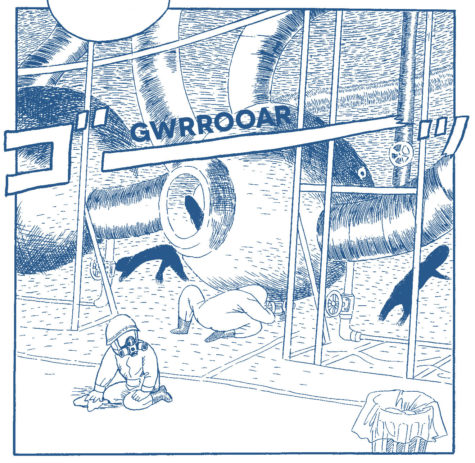“Fukushima Devil Fish”
 Ryan Holmberg writes: ‘Art changed in Japan after the tsunami and nuclear meltdowns of March 2011. So did art history—or at least it should have. That the disasters ushered in a new era in Japanese culture is widely recognized. That they also inspired a reappraisal of what had been made in the past is only partially so. Within weeks, scholars, publishers, and activists began to offer an array of previous responses to industrialized fission in Japan. Inevitably, Hiroshima and Nagasaki were on people’s lips. While protesters cried, “No More Hiroshimas! No More Fukushimas!†pundits repeatedly asked, “How could the only country to suffer nuclear attack become one of the greatest supporters of atomic energy?†Classics of disaster fiction, like Sakyo Komatsu’s Japan Sinks (1973), about the archipelago breaking in half from a massive earthquake, and Katsuhiro Otomo’s sci-fi dystopia Akira (1982-1990), about psychokinetic superkids in a post-atomic holocaust Tokyo, were praised anew as prophetic.’
Ryan Holmberg writes: ‘Art changed in Japan after the tsunami and nuclear meltdowns of March 2011. So did art history—or at least it should have. That the disasters ushered in a new era in Japanese culture is widely recognized. That they also inspired a reappraisal of what had been made in the past is only partially so. Within weeks, scholars, publishers, and activists began to offer an array of previous responses to industrialized fission in Japan. Inevitably, Hiroshima and Nagasaki were on people’s lips. While protesters cried, “No More Hiroshimas! No More Fukushimas!†pundits repeatedly asked, “How could the only country to suffer nuclear attack become one of the greatest supporters of atomic energy?†Classics of disaster fiction, like Sakyo Komatsu’s Japan Sinks (1973), about the archipelago breaking in half from a massive earthquake, and Katsuhiro Otomo’s sci-fi dystopia Akira (1982-1990), about psychokinetic superkids in a post-atomic holocaust Tokyo, were praised anew as prophetic.’
